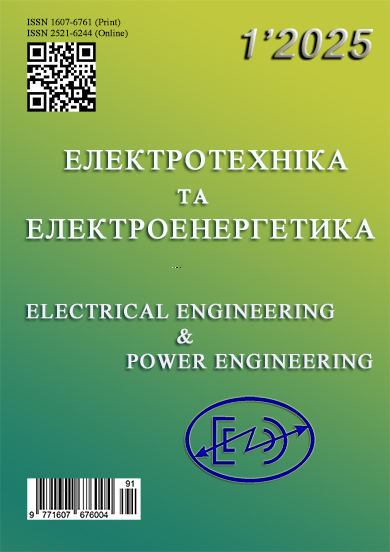Features of minimizing total electrical losses in high-voltage electromechanical systems for stationary industrial fan installations
DOI:
https://doi.org/10.15588/1607-6761-2025-1-2Keywords:
switching frequency, optimization, losses, energy efficiency, converter, high-voltage electromechanical systemAbstract
Purpose. Conduct a study of commutation processes and develop a methodology for determining the switching frequency of semiconductor elements in the converter for high-voltage electromechanical systems to minimize electrical losses during their operation with fan loads.
Methodology. Methods of multi-criteria and single-criteria optimization for finding the optimal values of electrical losses in an electromechanical system, methods for solving first-order differential equation systems, and analytical methods.
Findings. To improve the energy efficiency of a high-voltage electromechanical system for stationary industrial fan installations without modifying their structural design, the level of total losses has been assessed. A target function has been constructed to represent the dependence of total losses in the electric drive on the switching frequency of power switches and the harmonic distortion coefficients of the stator and rotor currents in a high-voltage wound-rotor asynchronous motor. Through approximation, a generating dependence of the switching frequency of the converter’s power switches on the harmonic distortion coefficient of the stator and rotor currents of the asynchronous motor has been established. The target function, initially dependent on three variables, has been transformed into a function of a single variable. Simulation modeling of electromagnetic and energy processes in the high-voltage electromechanical system has been conducted to evaluate total loss levels. A comparative analysis has been performed, confirming the adequacy of the obtained analytical expression for determining the optimal switching frequency of the converter’s power elements under the condition of minimizing losses in the high-voltage electromechanical system, with results validated through simulation.
Originality. A study of commutation processes in the power elements of the converter, which is part of the high-voltage electromechanical system, has been conducted. More precise analytical dependencies have been obtained, allowing for the determination of the main and commutation losses in the power elements of the converter for the high-voltage electromechanical system.
Practical value. A methodology for determining the optimal switching frequency of the semiconductor elements in the converter, which is part of the high-voltage electromechanical system, has been proposed. The calculation error of the optimal switching frequency of the semiconductor elements, obtained analytically, does not exceed 3.5% compared to the results obtained through simulation. The proposed methodology can be applied to minimizing losses in high-voltage electromechanical drive systems for both AC and DC applications used in various industrial mechanisms.
References
Antoshchenko N. I., Kalyuzhny V. V., Kotikov V. P., Tynda G. B., Andrienko P. D., Sadovoy A. V. (2014). New approach to regulation of ventilation of coal. Coal of Ukraine, 3, 29-32.
Pereverzev, A.V. (2004). Characteristics of step-up converters for uninterruptible power supply systems, Tekhnichna Elektrodinamika, 239.
Shaviolkin O.V. (2015). Power semiconductor energy converters, KhNUM University named after OHM. Beketova, 403.
Cheung, K., Cheung S. (2002). Large-Scale Energy Storage Systems, Imperial College London, 4 (12), 45 – 48.
Joao, L.A. (2005). P-Q theory power components cal-culations, IEEE: International symposium on indus-trial electronics, 6, 25-27.
Andrienko P.D., Kotsur M. I., Kotsur I.M. (2011) Pa-tent of Ukraine 64126, Int. Cl.3 Н02Р 27/05(2006.01) Prystryi impulsnogo keruvannya procesamy peretvorennya energiyi v asinkhronnomu dvyguni z faznym rotorom. [Device for impulse con-trol by energy coversion processes in wound-rotor in-duction motor] published 25.10.2011, Bulletin №20,
Kotsur M. I., Andrienko P. D., Kotsur I. M. (2012). Osobennosti rezhimov raboty modificirovannoy sis-temy impulsnogo regulirovaniya [Operation modes features of modificate pulse control system of asyn-chronous motor with phase rotor], Elektrome-chanichni ta enegrozberigayuchi sistemy, 19, 3, 163-165.
Synetskyi, A., & Kotsur, I. (2024). Determination of converter parameters for high-voltage electrome-chanical systems of stationary installations of indus-trial fans. Electrical Engineering and Power Engineer-ing, (3), 7–15. https://doi.org/10.15588/1607-6761-2024-3-1
Tunyasrirut S. (2008). DSP based modified slip energy recovery drive using a 12-pulse converter and shunt chopper for speed control system of a wound rotor induction motor, Electric Power System Research, 6, 861-872.
Kumar, A., Aggarwal S. K., Saini L. M. (2011). Per-formance analysis of a microcontroller based slip power recovery drive, International Journal of Engi-neering, Science and Technology, 3, 25 – 35.
Sivanagappa, V.J., Sarumathi M., Sivaranjani R., Soniya N., Sujeetha A. (2014). Slip Ring Induction Motor Power Factor Control Using Fuzzy Logic Con-troller, International Journal of P2P Network Trends and Technology (IJPTT), 4, 40-46.
Hilmi, А. (2006). High chopper frequency drive of wound rotor induction motor with a resistively loaded rotor chopper, IEEE: Transactions on Industrial Elec-tronics, 8, 100–108.
Tunyasrirut, S. (2008). DSP based modified slip ener-gy recovery drive using a 12-pulse converter and shunt chopper for speed control system of a wound rotor induction motor, IEEE: Electric Power System Research, 6, 861–872.
Ping, J., Bingshu W., Junwei Z. (2009). Simulation of a new method in double closed loop for slip power recovery motor with chopper proceedings, IEEE: Trans. on Power Electronics, 6, 6. – 66.
Dubey, G.K. (2008). Power semiconductor controlled drives, PHI. Edition, London, 440p.
WESTCODE. Katalog produkciyi. URL: http://www.westcode.com/products.html.
Downloads
Published
How to Cite
Issue
Section
License
Copyright (c) 2025 A.V. Synetskyi, I.M. Kotsur

This work is licensed under a Creative Commons Attribution-ShareAlike 4.0 International License.
Creative Commons Licensing Notifications in the Copyright Notices
Authors who publish with this journal agree to the following terms:
Authors retain copyright and grant the journal right of first publication with the work simultaneously licensed under aCreative Commons Attribution License that allows others to share the work with an acknowledgement of the work's authorship and initial publication in this journal.
Authors are able to enter into separate, additional contractual arrangements for the non-exclusive distribution of the journal's published version of the work (e.g., post it to an institutional repository or publish it in a book), with an acknowledgement of its initial publication in this journal.
Authors are permitted and encouraged to post their work online (e.g., in institutional repositories or on their website) prior to and during the submission process, as it can lead to productive exchanges, as well as earlier and greater citation of published work.

